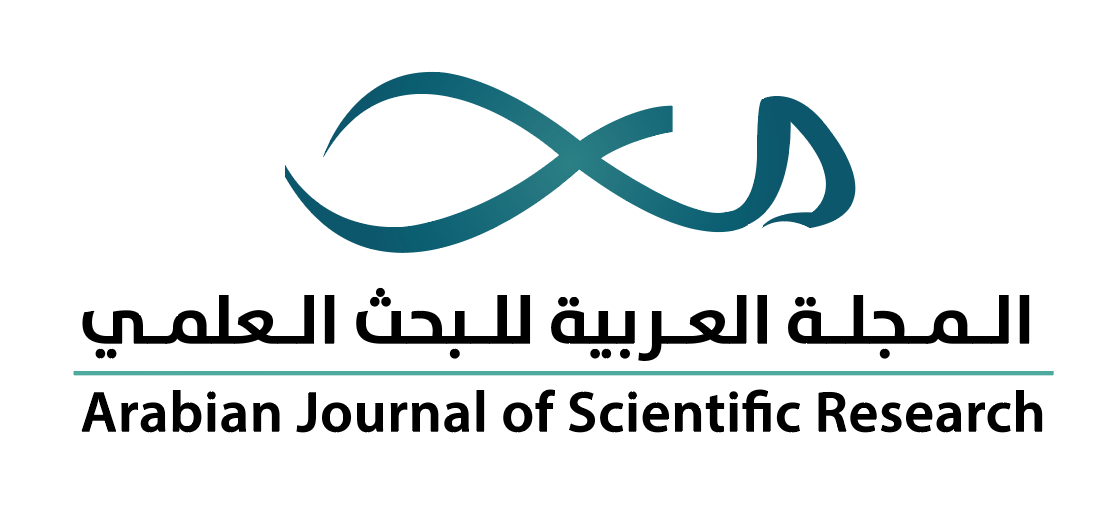- Home
- A-Z Publications
- Arabian Journal of Scientific Research-المجلة العربية للبحث العلمي
- Previous Issues
- Volume 2 (2021), Issue 2
Arabian Journal of Scientific Research-المجلة العربية للبحث العلمي - Volume 2 (2021), Issue 2
Volume 2 (2021), Issue 2
-
مقترح لتطبيق مرصد تلوث الانبعاثات التروبوسفيرية (TEMPO) التابع لوكالة ناسا: حمولة مستضافة لرصد الغلاف الجوي من مدار ثابت بالنسبة إلى الأرض (GEO)
More LessAuthors: رائد محمد سليمان, كلي تشانس and شونج شونجالملخص اختارت ناسا مرصد تلوث الانبعاثات التروبوسفيرية، المعروف اختصارًا بـ (TEMPO) "تمبو"، ليكون أول مرصد من برنامج "مشروع أجهزة قياس الأرض" ليتم إطلاقه الى الفضاء في نهاية عام 2022. وسيقيس "تمبو" تلوث الغلاف الجوي لقارة أمريكا الشمالية من الفضاء، باستخدام التحليل الطيفي المرئي والأشعة فوق البنفسجية؛ من مكسيكو سيتي وكوبا إلى منطقة أثاباسكا النفطية الكندية، ومن المحيط الأطلسي إلى المحيط الهادئ، كل ساعة وبدقة مكانية عالية (2 كم غرب/شرق بـ 4.5 شمال/جنوب، عند 35.5 درجة شمالًا و100 درجة Read More
-
رسالة في الميزان للأهوازي: تحقيق ودراسة لنصّ في علم الأثقال العربيّ من القرن الرابع الهجريّ
More LessBy محمد أبطويالملخص نخصِّص هذه المقالة لنشر التحقيق النقدي لنصّ علميّ ينتمي إلى التقليد العربي لعلم الأثقال الذي يمثّل الميكانيكا النظرية بمعناها القديم والوسيط. وهذا الـمُصنَّف هو رسالة في الميزان لرياضيٍّ عربيٍّ معروف هو أبو الحسن محمد بن عبد الله بن منصور الأهوازي الذي عاش في النصف الأول من القرن الرابع الهجريّ/القرن العاشر الميلاديّ. ألّف الأهوازي شرحًا للمقالة العاشرة لكتاب أصول الهندسة لأوقليدس، وتُنسَب إليه أعمال فلكية عديدة يبدو أنّها ضاعت أو لـمّا يُعثَر عليها بعد. ويُعَدّ نشرنا لرسالته القصيرة في الميزان أوّلَ تحقيق Read More
-
دور الاستشعار عن بعد في مراقبة أطوار نمو القمح لدعم إدارة العملية الإنتاجية في سوريا
More Lessالملخص تُمثل المحاصيل الاستراتيجية، وخاصة القمح، جوهر الأمن الغذائي. ويُعتبر القطاع الزراعي ذا تأثير مباشر في حياة الإنسان وغذائه، ولكن بما أنه الأكثر تعاملًا مع الظروف الطبيعية؛ فإن إدارته يجب أن تتم برؤية تكاملية لعناصر الإنتاج الطبيعية والبشرية خلال عملية النشاط المحصولي من مستوى الحقل حتى مستوى الدولة. تهدف هذه الدراسة إلى مراقبة علاقة الأطوار الفينولوجية للقمح بموعد النضج والحصاد في كافة أنحاء سوريا، بوسائل الاستشعار عن بعد ضمن علاقة "الزمكاف" (الزمان – مكان - طيف)، وذلك من أجل دقة تقدير الإنتاجية Read More
-
التحليل الكروماتوغرافي - الكتلي لبعض المركبات الفعالة حيويًا في اثنين من النباتات الطبية اليمنية
More LessAuthors: عيشة محمّد علي محسن, عادل أحمد محمّد سعيد and طه أبوبكر فضل سالمالملخص تمتلك النباتات الطبية العديد من المكونات ذات الفاعلية الحيوية المتأتية من منتجات الأيض الثانوية، وتستخدم لعلاج العديد من الأمراض. تناولت الدراسة اثنين من النباتات التي تنمو في اليمن والمستخدمة في الطب الشعبي، وهما اللافندر الزغبي (Lavandula pubescens Decne) والدورستينيا فويتيدا (Dorstenia foetida). تم التحليل النوعي للمستخلص الميثانولي للنباتين، لمعرفة نوعية مكونات الأيض الثانوية فيها بواسطة الكرموتوغرافيا السائلة عالية الأداء المرتبطة بمطيافية الكتلة (HPLC-MS). كشف التحليل عن وجود العديد من المك Read More
-
تقييم فاعلية بعض المطهرات والمعقمات على البكتيريا الزائفة (Pseudomonas) المعزولة من وحدة العناية المركّزة للمواليد في مستشفى مصراتة المركزي - ليبيا
More LessAuthors: أبوبكر الرطب, نورية المحجوب and فوزية أبودينةالملخص تهدف هذه الدراسة إلى تقييم مدى فاعلية وتأثير بعض المطهرات والمعقمات المستخدمة في المرافق الصحية، وخصوصًا في مستشفى مصراتة المركزي، بحسب التراكيز المعدّة لهذه المرافق، على مجموعة البكتيريا الزائفة (Pseudomonas) المعزولة من قسم الولادة ووحدة العناية المركّزة للأطفال حديثي الولادة بمستشفى مصراتة المركزي، في الفترة من 11 أكتوبر2017 إلى 8 مارس 2018، مع العامل الزمني لهذا التأثير، حيث كانت الأنواع المعزولة هي (Pseudomonas spp)، (Pseudomonas aeruginosa)، (pseudomallei Read More
-
مراقبة الأدوية العلاجية، الأساسيات والتحسين (مراجعة الخبراء)
More LessAuthors: أحمد شاكر علي and و مهران شاكر عبد الرحمنالملخص مراقبة الأدوية العلاجية هي خدمة سريرية تهدف إلى الاستخدام الأمثل للأدوية ذات النطاق العلاجي الضيق أو لها حركية دواء معقدة، وتشمل قياس تركيز الدواء في المصل أو الدم في العينات المأخوذة في أوقات مناسبة ومعلومة. ومن خلال فهم متعمق لخصائص الأدوية التي تم قياسها، ودراسة ملف المريض، يمكن تفسير تركيز الدواء في الدم لاستنباط الجرعة المثلى وفقًا لاحتياجات المريض الفردية. يهدف هذا البحث إلى تسليط الضوء على أساسيات الخدمة وتقديم اقتراحات لتحسينها، وخاصة في الدول النامية. ويقدم إرشادات عملية تضمن Read More
-
معالجة مادة المرجين بواسطة المبخر الطبيعي بوصفه نموذجًا إيكولوجيا: مثال من تونس
More LessAuthors: وفاء حسن, لطفي سوسية, أسماء بلطيفة, كريمة بكير, عفيفة بلعيد and الهادي بن منصورالملخص يعتبر قطاع إنتاج وتصدير زيت الزيتون من القطاعات الواعدة في تونس، حيث يشهد نموًا متواصلًا يواكب التحولات الكبرى، سواء على مستوى الإنتاج أو التحويل أو التصدير. ويأتي مع هذا التطور زيادة في إنتاج مادة المرجين، وهي مادة سائلة مستخلصة من عصر الزيتون تصنف بأنها مادة سامة وملوثٌ بيئي شديد التأثير متى ما صُرّفت في الطبيعة. تهدف هذه الدراسة إلى تصميم وتصنيع نموذج أولي لنظام مغلق للتبخر الطبيعي، يتميز بانخفاض تكلفته وسهولة تشغيله وحاجته إلى الصيانة أقل، له القدرة على تبخير 80٪ من مادة المرجين، وإنتاج 20 Read More
Volumes & issues
Most Read This Month
Article
content/journals/ajsr
Journal
10
5
true
en


